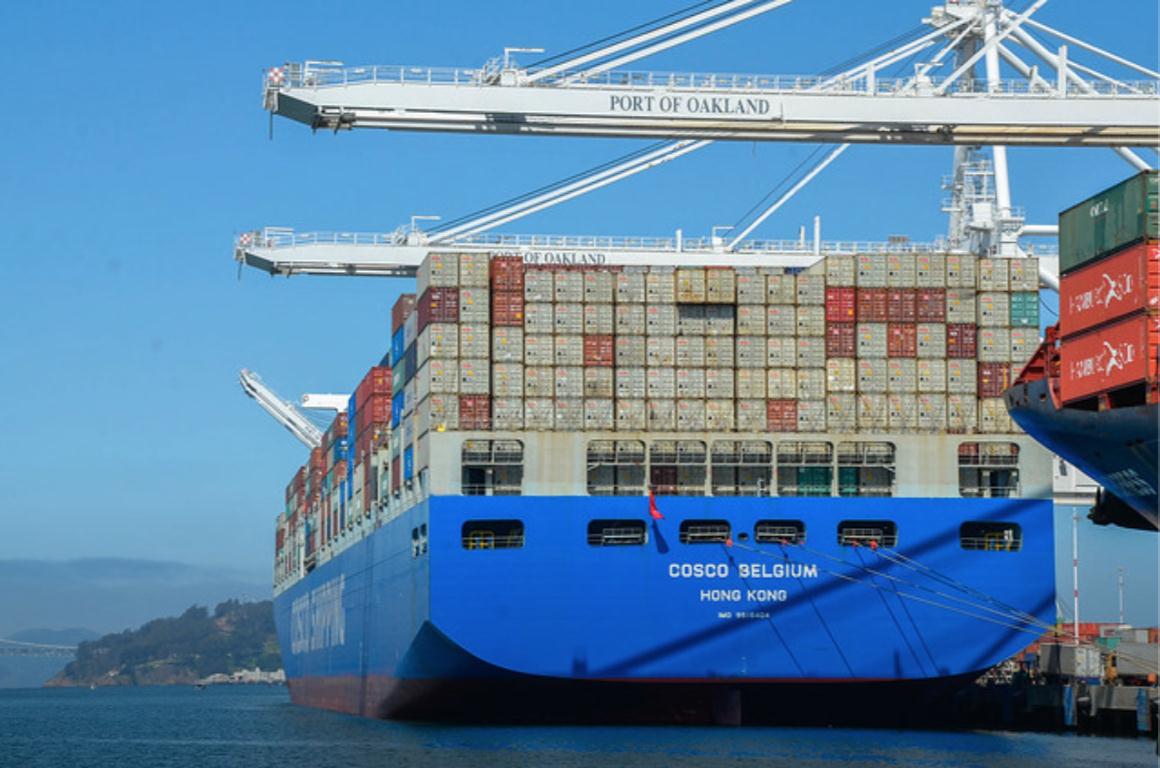The Port of Oakland has unleashed a number of initiatives to keep ahead of growth in container and reefer traffic. The latest move is bringing three 300-foot gantry cranes to the port that could be the tallest on the West Coast.
SSA Terminals, operator of the port’s largest container facility, is paying US$30 million for the three cranes that will be able to service the largest container vessels, which are expected to be delivered from China 18 months down the road. The cranes will have a lift height of 174 feet above the dock and can reach 225 feet across a ship’s deck.
“Big ships are the future,” declared Ed DeNike, president of SSA Containers. “They’re coming to Oakland and we’re going to be ready for them.
Oakland International Container Terminal, where the cranes will be deployed, handles over 60% of the port’s total cargo volume. When they come on stream, the operator will remove three of the 10 older cranes that are currently in service at the facility.
Three new cranes recently started work at the nearby TraPac marine terminal, which handles about 15% of the port’s container traffic. Their deployment was part of a US$67 million expansion project that doubled the facility’s footprint from 66 to 123 acres. The undertaking, which was completed in January, added a third dock and raised the number of cranes on site from four to seven.
The new dock is 1,400 feet long to accommodate mega container ships.
The terminal expansion also included a doubling of plug-in space for reefer containers, going from 388 to 860 spaces. A large chunk of the terminal’s throughput is reefer traffic headed to Japan.
Last November, cool storage specialist Lineage Logistics and Dreisbach Enterprises opened a US$90 million refrigerated distribution centre at the port.

Oakland’s exports edged up 0.6% in January, while containerized imports climbed 9%, which the port authority attributed to surges in traffic out of Asia ahead of the Lunar New Year break and lingering concern over higher tariffs. The 3.2% increase in overall container volume made it the port’s busiest January on record.
Other container facilities on the West Coast are also looking to beef up their capacity.
For the Port of Long Beach, further investment in on-dock rail capacity and increased chassis utilization are major priorities in 2019, according to port director Mario Cordero.
Long Beach handled 657,286 TEUs in January, just 0.1% off last January’s record throughput. The high volume of inbound containers, reflecting the surge in imports from China, caused delays in truck pick-ups and deliveries and congested warehouses.
For the past year Long Beach reported 7.2% growth in container volume, breaking through the 8 million TEU barrier.
The Port of Los Angeles was also grappling with congestion, as container volume rose 5.4% in January. It marked the seventh consecutive month that the port handled north of 800,000 TEUs.
Up north, the port authorities of Seattle and Tacoma, which have banded together under the Northwest Seaport Alliance (NSWA) banner, are looking to streamline container traffic at Seattle in a US$300 million revamp. They plan is centred on the redevelopment of the port’s Terminal 5 to make it the prime facility to handle large vessels up to 18,000 TEUs and handle a large chunk of the intermodal traffic headed to the US Midwest.
The commissioners intend to shift traffic from two smaller container facilities in Seattle’s congested downtown core to the revamped Terminal 5 or another container facility, both of which are located in the outer harbour.
For the NWSA, the move is less driven by anticipated growth in throughput than concern about losing business to rival ports north of the border. It has lost ground to Vancouver and Prince Rupert over the past five years.
Last year the NWSA handled 3.1 million TEUs, up 3.9% from its 2017 throughput. Vancouver’s container throughput climbed 4.4% in 2018 to reach 3.4 million TEUs, while Prince Rupert’s container terminal recorded 12% growth, breaking through the 1 million TEU barrier.
By Ian Putzger
Correspondent | Toronto